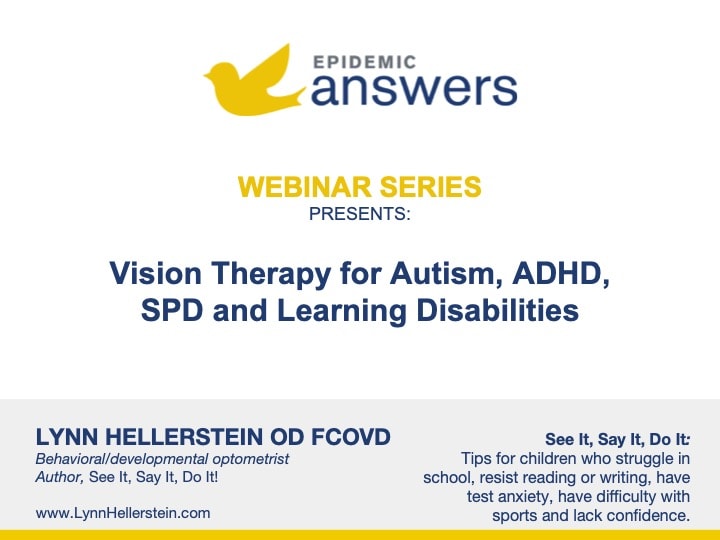Donna Wendelburg and Kathy Nurek, vision therapists and founders of Achievers Unlimited, Fond du Lac, WI, discuss the link between autism and vision in this post.
At birth, the structure, size, and growth of our eyes are almost complete. Once a baby is born, the eyes begin to learn how to function effectively with the body and the brain.
In order to function effectively, vision skills must automatically develop along with the baby’s motor and cognitive development. Up to 90% of individuals with autism lack the vision skills which provide optimal eye function. These skills have not developed automatically.
If an eyecare professional is able to carry out vision testing, we find most individuals with autism have 20/20 eyesight. Eyesight is the ability to see a certain size at a certain distance, momentarily. Vision, or the way our eyes function, is the ability to understand what we see, store the information, and retrieve what we know at a later time.
Normal Vision Development
At birth, babies don’t clearly see the world beyond their grasp. If you brush a newborn’s hand with your finger, the baby will grasp the finger. Eventually, the baby will begin to look at your finger after he/she grasps it.
At this stage of development the tactile sense is directing the baby’s vision. This is the first step in training the visual system. There are many steps in developing the visual system automatically.
Soon, the baby can locate an object visually, reach for it, and pick it up. By six months, babies manipulate toys with their hands, turning a toy around and around to allow the visual system to examine the toy from all angles. By 12 months, a child can glance at that toy from any direction and know that it is his/her toy.
As the visual system continues to develop it begins its lifelong task of directing the body and brain. The child learns to visualize the toy: “truck.” Language begins to develop, directed by the visual system. By 10 years of age, the goal of the visual system is integration: the ability to see an object, such as ice cream and know that it is cold without having to touch it.
Vision Development and Autism
Visual development is erratic in a child with autism. Eric, age 12, does not know that ice cream is cold without touching it. In Eric’s case, his tactile sense is still directing his body, brain, and visual system.
Eric’s world is still confined to objects he can see within his grasp. Eric does not see anything that he is not touching. Eric’s visual system is at the level of a newborn infant. The goal of a developed visual system is to direct the body. Since Eric’s tactile sense is still directing his body, he does not move out in space very well.
Yes, he can sit and walk and run, but Eric’s body never stops. He is constantly in motion, constantly running. Like a newborn, whose body moves without direction, Eric has not yet learned to stop and start his body. If we want Eric to stop running, we have to touch him on the shoulder. If we want Eric to sit in a chair, we have to direct him to the chair and press down on his shoulders.
Other children with autism may have different visual issues. Some children’s visual systems have not learned form “constancy,” and so they can spend hours looking at and holding a particular object. Here the visual system is in place, but on “idle.” Vision is reflexive, rather than directive.
Many individuals with autism develop a photographic memory to compensate for the lack of visual development. As long as the environment remains the same, they can function. If however, a piece of furniture is moved, these children may be upset – they do not know it is the same sofa because now they are seeing it from a different angle.
Results of Erratic Vision Development
Children with autism may have visual patterns that interfere with their ability to react and interact with their surroundings. These patterns include poor eye contact, looking through rather than at objects, using peripheral or central vision, and visually sweeping the room rather than looking at specific items in the room.
These visual patterns are caused by the lack of vision development skills, such as eye-hand coordination, eye-foot coordination, eye movement control, convergence, difficulty with eye contact and eye-hand-foot-brain coordination.
Vision skills impact a child’s ability to eat without spilling, walk without falling, and to be aware of surroundings. Poorly developed vision skills will affect a child’s penmanship, reading, attention span, and socialization skills.
Because vision development is erratic in an individual with autism, the visual system interferes with learning life skills and academics. An inefficient visual system causes the following:
- Inability to pay attention (child doesn’t work at near for long because of blur or double vision)
- Lack of form constancy (cannot recognize an object from another angle, resulting in rigid behavior – don’t move your furniture around)
- Language delays (lack of visualization)
- Lack of integration (knowing ice cream is cold without touching it)
- Inability to move out in space very well (can’t see beyond his/her grasp)
The Importance of Motor Development
Visual development is erratic in children with autism because the motor system is compromised. Unfortunately, motor development, the most essential area in dealing with autism, is often neglected in pursuit of developing the child’s intellect.
Understanding the visual components that accompany each stage of healthy motor development is the key to teaching vision skills that have not automatically developed in a child with autism. Because motor, visual, language, and cognitive development are all interrelated in a child with autism, vision therapy can be an important component of a multidisciplinary therapeutic approach.
Donna Wendelburg and Kathy Nurek, vision therapists and founders of Achievers Unlimited, Fond du Lac, WI, discuss the link between autism and vision in this post.
At birth, the structure, size, and growth of our eyes are almost complete. Once a baby is born, the eyes begin to learn how to function effectively with the body and the brain.
In order to function effectively, vision skills must automatically develop along with the baby’s motor and cognitive development. Up to 90% of individuals with autism lack the vision skills which provide optimal eye function. These skills have not developed automatically.
If an eyecare professional is able to carry out vision testing, we find most individuals with autism have 20/20 eyesight. Eyesight is the ability to see a certain size at a certain distance, momentarily. Vision, or the way our eyes function, is the ability to understand what we see, store the information, and retrieve what we know at a later time.
Normal Vision Development
At birth, babies don’t clearly see the world beyond their grasp. If you brush a newborn’s hand with your finger, the baby will grasp the finger. Eventually, the baby will begin to look at your finger after he/she grasps it.
At this stage of development the tactile sense is directing the baby’s vision. This is the first step in training the visual system. There are many steps in developing the visual system automatically.
Soon, the baby can locate an object visually, reach for it, and pick it up. By six months, babies manipulate toys with their hands, turning a toy around and around to allow the visual system to examine the toy from all angles. By 12 months, a child can glance at that toy from any direction and know that it is his/her toy.
As the visual system continues to develop it begins its lifelong task of directing the body and brain. The child learns to visualize the toy: “truck.” Language begins to develop, directed by the visual system. By 10 years of age, the goal of the visual system is integration: the ability to see an object, such as ice cream and know that it is cold without having to touch it.
Vision Development and Autism
Visual development is erratic in a child with autism. Eric, age 12, does not know that ice cream is cold without touching it. In Eric’s case, his tactile sense is still directing his body, brain, and visual system.
Eric’s world is still confined to objects he can see within his grasp. Eric does not see anything that he is not touching. Eric’s visual system is at the level of a newborn infant. The goal of a developed visual system is to direct the body. Since Eric’s tactile sense is still directing his body, he does not move out in space very well.
Yes, he can sit and walk and run, but Eric’s body never stops. He is constantly in motion, constantly running. Like a newborn, whose body moves without direction, Eric has not yet learned to stop and start his body. If we want Eric to stop running, we have to touch him on the shoulder. If we want Eric to sit in a chair, we have to direct him to the chair and press down on his shoulders.
Other children with autism may have different visual issues. Some children’s visual systems have not learned form “constancy,” and so they can spend hours looking at and holding a particular object. Here the visual system is in place, but on “idle.” Vision is reflexive, rather than directive.
Many individuals with autism develop a photographic memory to compensate for the lack of visual development. As long as the environment remains the same, they can function. If however, a piece of furniture is moved, these children may be upset – they do not know it is the same sofa because now they are seeing it from a different angle.
Results of Erratic Vision Development
Children with autism may have visual patterns that interfere with their ability to react and interact with their surroundings. These patterns include poor eye contact, looking through rather than at objects, using peripheral or central vision, and visually sweeping the room rather than looking at specific items in the room.
These visual patterns are caused by the lack of vision development skills, such as eye-hand coordination, eye-foot coordination, eye movement control, convergence, difficulty with eye contact and eye-hand-foot-brain coordination.
Vision skills impact a child’s ability to eat without spilling, walk without falling, and to be aware of surroundings. Poorly developed vision skills will affect a child’s penmanship, reading, attention span, and socialization skills.
Because vision development is erratic in an individual with autism, the visual system interferes with learning life skills and academics. An inefficient visual system causes the following:
- Inability to pay attention (child doesn’t work at near for long because of blur or double vision)
- Lack of form constancy (cannot recognize an object from another angle, resulting in rigid behavior – don’t move your furniture around)
- Language delays (lack of visualization)
- Lack of integration (knowing ice cream is cold without touching it)
- Inability to move out in space very well (can’t see beyond his/her grasp)
The Importance of Motor Development
Visual development is erratic in children with autism, because the motor system is compromised. Unfortunately, motor development, the most essential area in dealing with autism, is often neglected in pursuit of developing the child’s intellect.
Understanding the visual components that accompany each stage of healthy motor development is the key to teaching vision skills that have not automatically developed in a child with autism. Because motor, visual, language, and cognitive development are all interrelated in a child with autism, vision therapy can be an important component of a multidisciplinary therapeutic approach.
Still Looking for Answers?
Visit the Epidemic Answers Practitioner Directory to find a practitioner near you.
Join us inside our online membership community for parents, Healing Together, where you’ll find even more healing resources, expert guidance, and a community to support you every step of your child’s healing journey.




